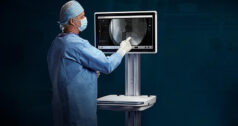
Computer-assisted fluoroscopic navigation and surgical robots are used to enhance implant placement and alignment in primary total hip arthroplasty (THA). A new study published in the December 2024 Journal of the American Academy of Orthopaedic Surgeons reported that navigation provides significant advantages over robotic assistance in terms of improving outcomes and lowering the cost of care for THA patients.
It’s reportedly the first study to compare the effects of using computer-assisted fluoroscopic navigation to robotic technology during THA on health and economic outcomes from a large population perspective.
The researchers analyzed class-level hospital billing data from January 2016 to September 2021 to assess the clinical and economic impact of 4,378 primary THAs involving digital fluoroscopic navigation and 10,423 procedures in which robotic assistance was used.
According to the findings, navigation reduced O.R. time by an average of 18 more minutes than robotic assistance and outperformed the use of a robot in reducing post-op hip-related readmission rates at 90 days (43%) and 365 days (40%). Navigation also bested robotic assistance by reducing postoperative length of stay by 8%, post-op discharge to skilled nursing homes by 29% and 90-day hip-related costs of care by 10%.
Navigation was associated with markedly lower O.R. time and readmission rates, improved patient outcomes and lower hospital costs compared to robotic-assisted technology, wrote the researchers. They noted that the use of hip navigation could be a factor in the smoother scheduling of cases and faster recoveries.
Preoperative imaging and capital equipment costs were not included in the study’s analysis, which suggests the difference in cost outcomes between the use of navigation and robotic assistance could be greater than the findings indicate. The higher expense associated with robotic-assisted procedures could be attributable to disposable equipment and surgical supplies, according to the researchers.
The most frequent reason for inpatient readmission was infection, accounting for close to 40% of readmissions within both patient groups. Implant-related infections were associated with 3% of readmissions for patients who had robotic-assisted THA. None of the patients who underwent procedures involving navigation suffered a deep infection, which the researchers said could be tied to the lack of pins needing to be inserted for fluoroscopic navigation or the shorter surgical times.
Jenna Bernstein, M.D., a surgeon at Connecticut Orthopaedics, was lead author of the study, which was funded by Johnson & Johnson MedTech and provides valuable information on the potential benefits and drawbacks of using navigation or robotic assistance in THA.
The study noted that the clinical improvements associated with navigation translate to a reduction in per-patient costs, which supports sustainable, value-driven healthcare.
“As digital technology increasingly enters joint surgeries, it’s critical to consider whether all technologies deliver meaningful benefits,” the researchers wrote. “This study demonstrates that digital fluoroscopic navigation offers clear, measurable improvements over robotic alternatives.”
DC
Dan Cook is a Senior Editor at ORTHOWORLD. He develops content focused on important industry trends, top thought leaders and innovative technologies.




